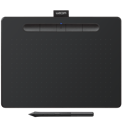Pen tablets
Sketch, draw and edit images with a responsive pad, a precise pen and see your creations appear on screen.


When you learn how to edit videos, it’s important to try and master a variety of techniques. This will help you understand different ways to move a story along, as well as discover favorite approaches that can become signature styles as you grow in confidence. Get to grips with these different techniques as you learn video editing and you’ll be creating impressive work in no time.
Montages are the perfect device for moving a character’s development or a storyline along quickly. Made up of short cuts and usually soundtracked by a single song or piece of music, they allow video editors to make the most of lots of different shots in one quick scene. Getting them right requires skill, lots of footage and an understanding of where you want your film and its characters to be once the montage has ended. Classic montages include the start of Disney Pixar’s Up, the training scenes in every Rocky movie and the end of Donnie Darko.

Using a match cut allows video editors to create continuity between scenes by matching the action or the subject from one scene to the next. This gives editor the opportunity to move a story along quickly between seemingly unrelated scenes without confusing the viewer. Classic examples include the ape throwing a bone in the air at the start of 2001: A Space Odyssey, with a match cut turning the bone into a satellite, and Lawrence of Arabia blowing out a match which then cuts to the sun rising over the desert. To master match cuts, try to consider what objects and subjects relate to each other, however obliquely, and think how they could be put together to make your film look professional.
J and L cuts are common techniques used when editors want to utilize audio from one scene over the video of another. An L cut is when the audio from the first scene carries on over the footage of the second. A J cut is the opposite, with audio from the second scene heard while the first scene is still on screen. It’s fun to play around with the timing of when audio comes in on certain scenes, with the overlaps helping to tie things together if they’re placed correctly.

This is a simple but effective tool that all video editors should master. The technique is just as it sounds, cutting as action takes place, either ending a scene or switching to a different angle. This makes the action’s impact more powerful, with the best editors switching angles and cutting quickly in order to keep viewers hooked. Fight scenes in The Matrix and the numerous shoot outs in Pulp Fiction are perfect examples of cutting on action.
Music’s role in video editing should not be underestimated. In fact, sound should have equal weight with visuals. Make sure montages fit neatly with songs or music that you use. It’s worth paying to licence music or have music made for your film if you can, as royalty free tracks can often be poor quality and let the entire finished product down. Movies by PT Anderson and Wes Anderson demonstrate how to edit well to music, especially with montages.
Cutaways allow video editors to develop a character or scene with just a few frames from different angles. Rather than focusing just on what a character or subject is saying, these simple cuts help build a picture quickly, focusing on objects that are around them. If a gun is going to be used in a scene, a quick cutaway to this will signal to viewers its importance and the fact that it will sooner or later be fired. This technique requires placing lots of small cuts within a longer scene and a clear understanding of what you want the scene to show. Learning how to use video editing software properly will help develop cutaway skills.
Parallel editing is the process of cutting between scenes that are occurring at the same time. By moving between the two, editors can build tension, especially if the audio remains the same across the footage by using J or L cuts. It’s a tried and tested tactic in thriller and fantasy movies, in particular The Lord of the Rings trilogy.

Getting export settings right will ensure that the final file size of your film isn’t too big to play back on devices such as smartphones and tablets. Be sure to understand codecs – these are the file formats your video will be saved as. Keep the resolution down if you’re producing a video for YouTube or Vimeo and ensure the frame rate is right: 24 frames per second for film and 30 frames per second for TV. Failure to grasp this might mean your video struggles to play on popular online platforms.
Wacom Intuos allows you to make the most of all the video editing techniques at your disposal. With over 4,000 pressure levels and ergonomic design, the pen feels completely natural in your hand, giving you outstanding control. Wacom Intuos is really easy to use. Simply connect to your Mac or PC, as well as certain Android devices. Plus with Bluetooth, you can connect to your computer at the click of a button. Create great-looking videos in no time with Wacom Intuos.
Recommended product

Wacom Intuos Bluetooth
Sketch, draw and edit images with a responsive pad, a precise pen and see your creations appear on screen.

Sketch, draw and edit images with a responsive pad, a precise pen and see your creations appear on screen.

Draw, design and create directly on a high resolution screen with a precise pen.


透過自然的介面技術讓人與科技緊密相依,是 Wacom 一貫的願景。這項願景讓 Wacom 成長為全球的互動式數位板、手寫液晶顯示器及數位筆的龍頭製造商,更是數位簽章保存與處理解決方案供應商。Wacom 直覺式輸入裝置的先進技術,已在全球各地造就出許多一流數位藝術、電影、特效、時尚及設計鉅作,其領先的介面技術同時為商業和家庭用戶提供表達自我個性的利器。創立於 1983 年的 Wacom 是全球性企業,總部位於日本(東京證券交易所股號:6727),分公司及行銷與銷售代表處遍佈世界各地 150 多個國家。